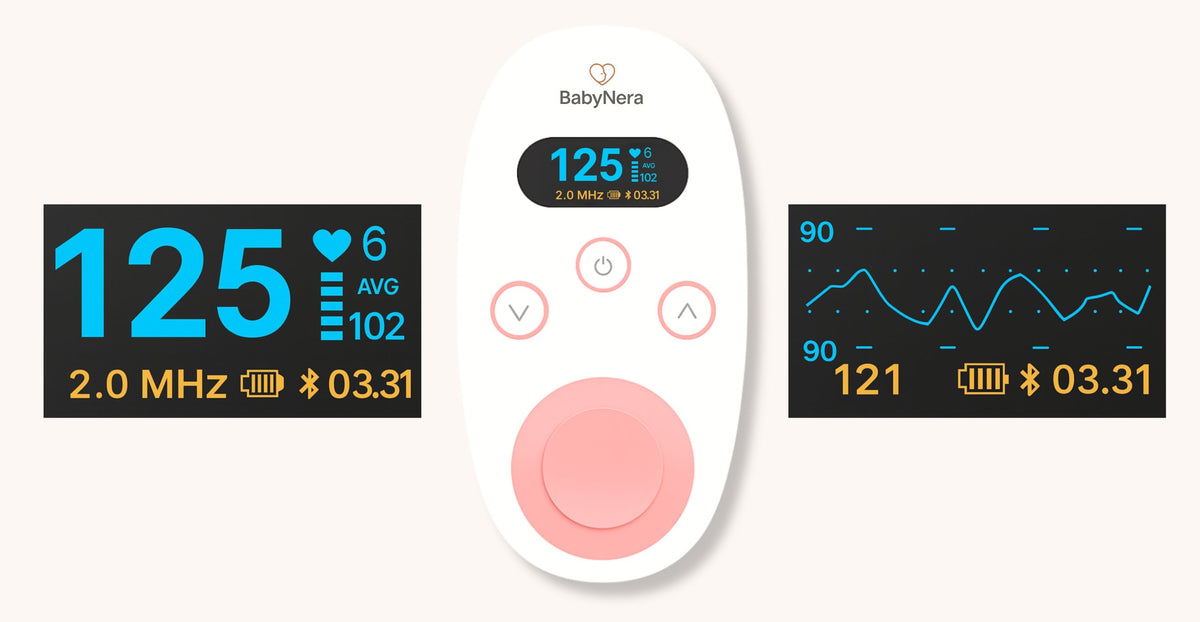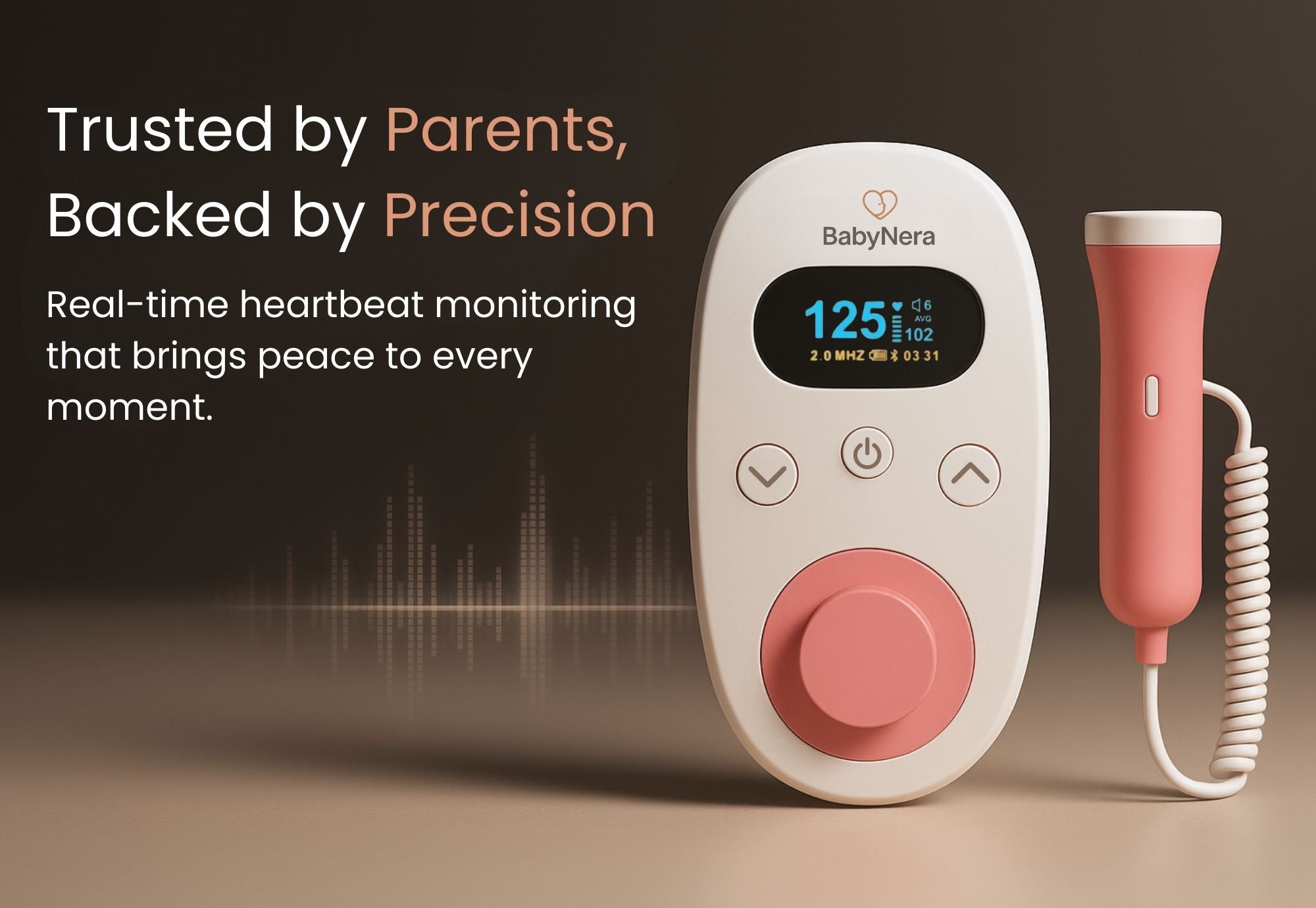
Precision Dual Display Modes
Two built-in views:
- Real-time BPM display
- Curve graph showing heartbeat patterns
1. Dual Measurement Modes
Switch between digital and curve display modes for flexible monitoring.
2. High-Contrast OLED Display
Blue-and-yellow OLED screen offers crystal-clear fetal heart rate readings.
3. All-in-One Design
Sleek, integrated body design with enhanced tactile comfort and portability.
4. Compact & Travel-Friendly
Lightweight and palm-sized for easy use at home or on the go.
Device Dimensions: 135 × 70 × 40 mm
5. Intelligent Signal Indicator
Helps users locate fetal heartbeats quickly and accurately.
6. Early Detection Algorithm
Detects fetal heartbeat as early as 9 weeks.
7. Medical-Grade DSP Technology
Uses advanced Digital Signal Processing (DSP) for reliable and accurate heart rate detection, comparable to hospital-grade monitors.
8. Safe 2.0 MHz Ultrasound
Working frequency deviation is ≤ ±5% for safe, consistent monitoring.
9. Adjustable Volume Control
Easily adjust sound level for comfort and clarity.
10. Battery-Powered & Auto Shut-Off
Operates on two AA batteries with 1-minute auto shut-off when no signal is detected.
Ultrasound Frequency: 2.0 MHz ±5%
Sensitivity: ≥90 dB at 200mm probe distance
Fetal Heart Rate Range: 50–210 bpm (±2 bpm accuracy)
Over 120,000+ Moms chose BabyNera since 2020









































When you can’t feel baby…
when they’re resting
Based on a survey of 200 parents.

Two built-in views:



Hear every heartbeat your way:

Designed for every body and every stage, BabyNera delivers clear sound through any bump size or BMI.
Clear, reliable, and gentle for at-home listening between visits.
For reassurance between prenatal visits. Not a substitute for professional medical care. Always follow your clinician’s guidance.


Turn everyday moments into memories—hear baby’s heartbeat at home, share it with family, and enjoy a little peace whenever you like.
“Our parents overseas heard their grandbaby’s heartbeat.” — Chloe
“We heard her heartbeat in seconds—such a sweet surprise.” — Emily
“It turned a little sound into a memory we’ll keep.” — Amanda
“Clear sound with my plus-size bump—so comforting.” — Jessica
“Our son asks to ‘hear baby’ before bed—it’s become our ritual.” — Sarah

Simple steps, position tips, and reference ranges—beautifully in one place.



Heartbeat position often shifts as pregnancy progresses.

Typically found along the lower abdominal midline or slightly to the sides.

Often detected on the lower left or right side as the fetus grows upward.

Commonly heard on the upper or lower sides of the belly. Note: Often opposite the side of fetal movement.
A healthy fetal heart rate typically ranges from 120 to 160 beats per minute.

Approx. 162 bpm

Approx. 147 bpm

Approx. 139 bpm
We’re always here if you need us — reach out anytime at support@babynera.com or chat with us online.
BabyNera Echo™ at-home fetal doppler is designed to detect your baby’s heartbeat from the first trimester. While some users may hear it as early as 9–10 weeks, this can vary depending on factors such as baby’s position, placenta placement, and body type.
The vast majority—over 98% of users—are able to detect a heartbeat by around 12 weeks.
Yes, BabyNera is a medical-grade, home-use device designed with safety in mind. While it’s safe for regular use, we recommend keeping sessions short and using it as a tool for reassurance—not a replacement for other ways of connecting with your baby, like feeling movements or attending medical checkups.
Yes. BabyNera uses safe, low-intensity ultrasound (2.0 MHz), similar to what's used during clinical prenatal visits. It is non-invasive and safe when used as directed.
Your baby’s heartbeat may sound like a fast galloping horse—typically 120–160 beats per minute. It's distinct from your own pulse, which may also be detected.
Yes. BabyNera’s at-home fetal doppler offers medical-grade accuracy (±2 BPM), making it one of the most precise options for home use. However, certain factors may affect readings, including but not limited to:
For the most accurate results, we recommend using the device in a quiet environment and following the instructions provided.
While BabyNera provides a helpful way to hear your baby’s heartbeat at home, it’s not intended to replace routine ultrasounds or prenatal visits. We encourage all parents to follow their healthcare provider’s guidance for a healthy and supported pregnancy journey.
BabyNera offers clinical-level accuracy from the comfort of home. It’s scientifically tested for safe, effective fetal heart rate monitoring—giving you results in minutes without needing to wait for appointments, travel, or long queues. It’s reassurance, on your schedule.
STEP 1: Prepare the Device
STEP 2: Apply Gel & Power On
STEP 3: Locate the Heartbeat
STEP 4: After Use
If you’re having trouble picking up a heartbeat, don’t worry—it’s common, especially in early pregnancy. The heartbeat can be faint or move depending on baby’s position. Try the steps below:
✅ Tips to Improve Detection
⚙️ If You See ~130 BPM but Hear Nothing
The device may display a temporary placeholder (around 130 BPM) while searching. Once the real heartbeat is found, it will automatically update—usually within 15 seconds.
🔧 Troubleshooting Steps
1. Unplug and re-plug the probe to ensure a proper connection.
2. Use enough gel to avoid interference.
3. Move the probe slowly from the lower belly upward.
4. Hold still once you hear the heartbeat—wait 15–20 seconds for BPM to stabilize.
5. Expected BPM range: typically 120–160.
6. Keep probe and main unit slightly apart when powered on.
7. If readings are unstable, gently shift position to locate a clearer sound.
✅ Test the Device
To check if the doppler is working, place it over your own heartbeat (left chest area, not wrist). If it reads and plays a steady BPM, the device is functioning properly.